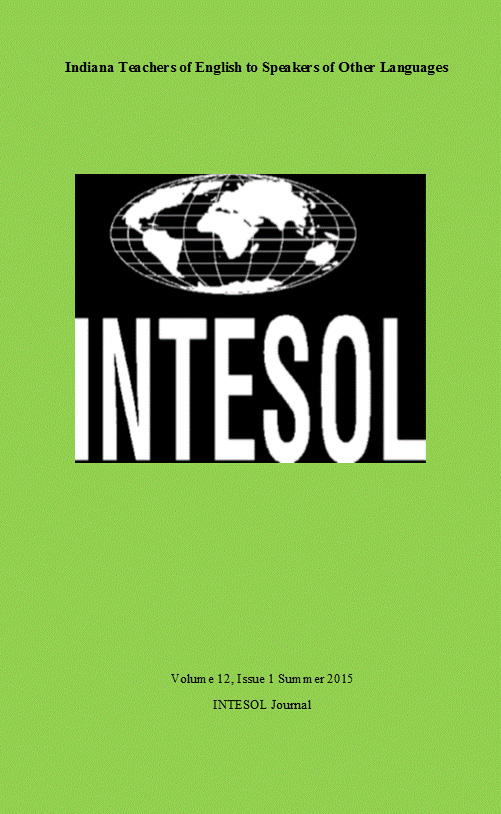From locally created to nationally sanctioned: The Indiana English language proficiency standards to the WIDA English language development standards
Abstract
English Language Proficiency/Development Standards (ELP/D) in Indiana is a result of the federal school accountability law of No Child Left Behind (NCLB, 2001). ELP/D standards are intended to be connected and/or aligned with academic content standards and are intended to guide how instruction and assessment is offered and how English language learners (ELLs) can perform those standards, depending on their English proficiency level. With the transition from the Indiana ELP/D standards adopted in 2003 to the newly adopted World Class Instructional Design and Assessment (WIDA) English Language Development standards in 2013, this paper explores the history of ELP/D standards in Indiana. This ten-year retrospective examines how the standards have impacted the overall instructional conditions for ELLs.
References
Bailey, A.L., & Carroll, P.E. (2015). Assessment of English language learners in the era of new academic content standards. Review of Research in Education, 39, 254-294. doi: 10.3102/0091732X14556074
Bailey, A.L., & Huang, A. (2011). Do current English language development/proficiency standards reflect the English needed for success in school? Language Testing, 28(3), 343–365. doi: 10.1177/0265532211404187
Boals, T.J., Kenyon, D.M., Blair, A., Cranley, M.E., Wilmes, C., & Wright, L. (2015). Transformation in K–12 English language proficiency assessment: changing contexts, changing constructs. Review of Research in Education, 39, 122-164. doi: 10.3102/0091732X14556072
Chamot, A.U., & O'Malley, J. M. (1994). The CALLA handbook : implementing the cognitive academic language learning approach. Reading, MA: Longman.
Creswell, John W. (2014). Research design: qualitative, quantitative, and mixed methods approaches (4th ed.). Thousand Oaks, CA: SAGE Publications.
CTB McGraw-Hill. (2007). LAS Links: Connecting assessment, language, and learning [Brochure]. Monterey, CA: CTB McGraw-Hill.
Davies, P. (2000). The relevance of systematic reviews to educational policy and practice. Oxford Review of Education, 26(2 & 3), 365-378. doi: 10.1080/3054980020001882
Echevarria, J., Short, D., & Vogt, M. (2008). Implementing the SIOP model through effective professional development and coaching. Boston: Pearson/Allyn and Bacon.
Echevarria, J., Vogt, M., & Short, D. (2000). Making content comprehensible for English language learners : the SIOP model. Boston, MA: Allyn and Bacon.
Echevarria, J., Vogt, M., & Short, D. (2004). Making content comprehensible for English learners : the SIOP model (2nd ed.). Boston: Pearson.
Echevarria, J., Vogt, M., & Short, D. (2006). Administrators' resource guide for the SIOP model. Glenview, Ill: Pearson.
Gottlieb, M.H. (2006). Assessing English language learners : bridges from language proficiency to academic achievement. Thousand Oaks, CA: Corwin Press.
Gottlieb, M.H., & Nguyen, D. (2007). Assessment and accountability in language education programs : a guide for administrators and teachers. Philadelphia, PA: Caslon Pub.
Indiana Department of Education. (1990). Procedures to assess language proficiency resource manual. Indianapolis, IN: Author.
Indiana Department of Education. (2000a). Indiana's Academic Standards: English language arts Teacher's Edition. Indianapolis, IN: Indiana Department of Education.
Indiana Department of Education. (2000b). Indiana's Academic Standards: teacher's edition English language arts. Indianapolis, IN: Author.
Indiana Department of Education & Indiana ESL Taskforce. (2003). Indiana's English Language Proficiency Standards. Indianapolis, IN: Indiana Department of Education.
Indiana Department of Education's Division of Language Minority and Migrant Education (2005, March 1). [English Language Development Assessment (ELDA) Field Test].
Mohan, B.A. (1986). Language and content. Reading, MA: Addison-Wesley.
Morita-Mullaney, T. (2007). Assessment: Collaboration in assessment: Secondary and ELL teachers teaming together In F. Pawan & G. Sietman (Eds.), Helping English Language Learners succeed in middle and high school (pp. 85-101). Alexandria, VA: TESOL.
Morita-Mullaney, T. (2012). English language proficiency standards and assessments: WIDA and ACCESS proposal from the EL leadership group Indiana Teachers of English to Speakers of Other Languages Leadership Group. Indianapolis, IN.
No Child Left Behind, Pub.L. 107–110, 115 Stat. 1425 (2001).
Short, D. (2000). The ESL standards: bridging the academic gap for English language learners. Washington, DC: ERIC Clearinghouse on Languages and Linguistics.
Short, D., Vogt, M., & Echevarria, J. (2008). The SIOP model for administrators. Boston, MA: Pearson.
Sireci, S.G., & Faulkner-Bond, M. (2015). Promoting validity in the assessment of English learners. Review of Research in Education, 39, 215-252. doi: 10.3102/0091732X14557003
Tanenbaum, C., Boyle, A., Soga, K., Le Floch, K.C., Golden, L., Petroccia, M., . . . Taylor, J. (2012). National Evaluation of Title III Implementation: Report on State and Local Implementation. Washington, DC: American Institutes for Research.
Teachers of English to Speakers of Other Languages. (1997). ESL standards for pre-k-12 students. Alexandria, VA: TESOL.
Téllez, K., & Mosqueda, E. (2015). Developing teachers’ knowledge and skills at the intersection of English language learners and language assessment. Review of Research in Education, 39, 87-121. doi: 10.3102/0091732X14554552
Tyack, D., & Cuban, L. (2007). Tinkering toward utopia: A century of public school reform. Cambridge, MA: Harvard University Press.
US Department of Education. (2006). Consolidated state performance report: parts I and II--state by state reports. In US Department of Education (Ed.), State formula grants programs under the elementary and secondary education act as amended by the No Child Left Behind Act of 2001 for reporting on school year 2005-2006. Washington, DC.: Author.
Vogt, M., & Echevarria, J. (2008). 99 ideas and activities for teaching English learners with the SIOP model. Boston, MA: Pearson.
World-class Instruction Design and Assessment. (2014). Can-Do Descriptors of English Language Proficiency Standards. from http://www.wida.us
Zehr, M.A. (2006). New era for testing English-Learners begins. Education Week, 25(42), 28-29.


